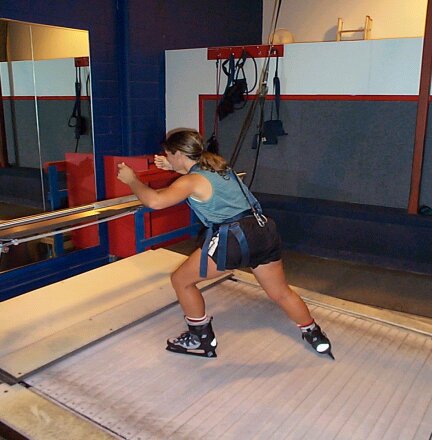Training at Minnesota Acceleration
by Jill Troutner and Jen McGill
June 23, 2001
Biathlon is sport that requires a unique combination of
power, aerobic capacity, and accuracy. This year when I watched
the US Biathlon Nationals in West Yellowstone, Montana, I
couldn't fathom how skiers who were racing so incredibly fast,
could breeze into the shooting range and have the composure
to hit every target. When Jill Troutner, member of the US
National Summer Biathlon Team and 1999 World Championship
Winter Biathlon Team, described what she does for training,
I was curious. One element of Jill's dryland utilizes Frappier
Acceleration Sports Training. I found it intriguing and perhaps
even blasphemous to learn about training that didn't involve
arduous hours of masochism and is not endorsed by Norwegians.
Anxious to learn more, this spring I asked Jill to take me
to the Acceleration Minnesota training facility in Arden Hills
and show me the equipment that she uses for training. Between
the highly specialized equipment--ice treadmill, sprinting
treadmill, and strength power cords--and the friendly low-key
atmosphere I was overwhelmed. Through her exercise regime
on the Frappier equipment, she has made great gains her development
of speed, agility, and power.
For winter biathlon Jill focuses on the ice treadmill, plyometrics,
and cords, while in the summer when her races entail running
instead of skiing, she trains on the running treadmill. With
the help of veteran skating coach Curt Carbaugh, Jill has
developed extremely specific workouts on the ice treadmill
emphasizing glide and power. All skating techniques can be
used as the incline and speed of the treadmill changes to
simulate natural terrain variations. When I stepped onto the
"ice," I was surprised by how much it felt like skiing on
snow. The hills on the treadmill are brutal. You can barely
eek out a V1. Like any other self-respecting mid-western golf
course skier, I preferred V2-ing on the treadmill flats. One
of the main highlights of the ice treadmill is that it is
an ultra-safe uninhibited environment in which you can really
push yourself. Unlike rollerskiing, I took comfort in the
fact that there were no cars, water hazards, or pedestrians
on the treadmill. When you skate on the treadmill, Curt straps
you into a safety harness, a cross between a seatbelt and
a climbing harness. Though it looked like a medieval torture
device, wearing the harness wasn't uncomfortable; in fact
it gave me a psychological boost knowing that it would prevent
me from falling down or off the treadmill. For extra resistance
to recruit hip flexors for a more powerful recovery cords
are often added to the skaters' legs. While it sounded like
lots of fun, I chose to skip the cord shackling experience.
Another valuable training tool at the Minnesota Acceleration
facility is their specialized running treadmill. This treadmill
is longer and wider than the average health club power walking
machine. While using the treadmill at steep inclines and high
tempos, runners learn to increase stride length and frequency.
The Acceleration staff takes each runner through a sport specific
workout designed to increase lactate tolerance, improve running
biomechanics, and ultimately increase speed. Sometimes the
trainers attach cords to the athlete's arms or legs to increase
resistance during running sessions. These SprintCords allow
athletes to increase knee drive and hip power through a full
range of motion.
At first glance the plyometric program looked like highly
sophisticated form of playground hopscotch. On closer scrutiny
I discovered these plyometric routines are great for skiers
for several reasons: They help to improve balance, increase
awareness of body position, enhance quad, calf and hip strength,
as well as develop quickness and lateral agility. The basic
plyo routine involves a fast paced circuit of jumping and
footwork drills interwoven with an excruciating array of core
strength drills. For pure strength and explosive power, trainers
often integrate their trademark Plyo Press and four-way hip
machine to recruit the hip flexors, extensors, abductors and
adductors in conjunction with the quads and glutes. The beauty
of the Plyo Press is that it simulates a jump or a squat in
a controlled but athletic movement without the need for a
spotter. By utilizing percentages of body weight the Plyo
Press ensures a safe leg load.
After seeing and trying the machines in Arden Hills I am
convinced that the Frappier Acceleration Sports Training methods
are an excellent supplement for nordic dryland training. While
their routines are non-traditional, they are a terrific means
for developing speed, agility, and power for the winter race
season. The one-on-one success oriented individualized training
with an Acceleration coach is invaluable. If you would like
to learn more about the programs at The Minnesota Acceleration
their staff would gladly answer any questions you might have.

Jen McGill skating away on the ice treadmill
|
More About Frappier Acceleration Training...
The Frappier Acceleration Program began in 1986 after John Frappier
returned from studying in the former Soviet Union. Drawing on
what he learned from their doctors and researchers lead to combining
Soviet block and free world technology into the Frappier Acceleration
Program. An international group of orthopedic surgeons, physical
therapists, exercise physiologists, and athletic trainers have
contributed to the Frappier Acceleration protocols and its constant
evolution. Training protocols include everything from Nordic
skiing, running, swimming, hockey, and more. Frappier acceleration
programs can be found in over 85 locations and in three countries.
Table 1 shows a brief summary of outcomes from their skating
and running programs.
| Skating |
Running
|
| 50 % reduction in recovery rates |
50 % reduction in recovery rates |
| Average increase in vertical jump of 4 inches |
Average increase in vertical jump of 4 inches |
| Average decrease in 20 foot on-ice sprints by .20
seconds |
Average decrease in 40 yard sprint times by .20 second |
| Increased stride length of over 10" (7-8mph @ 10�
grade) |
|
Table 1. Frappier Acceleration Outcomes
Related links
|



